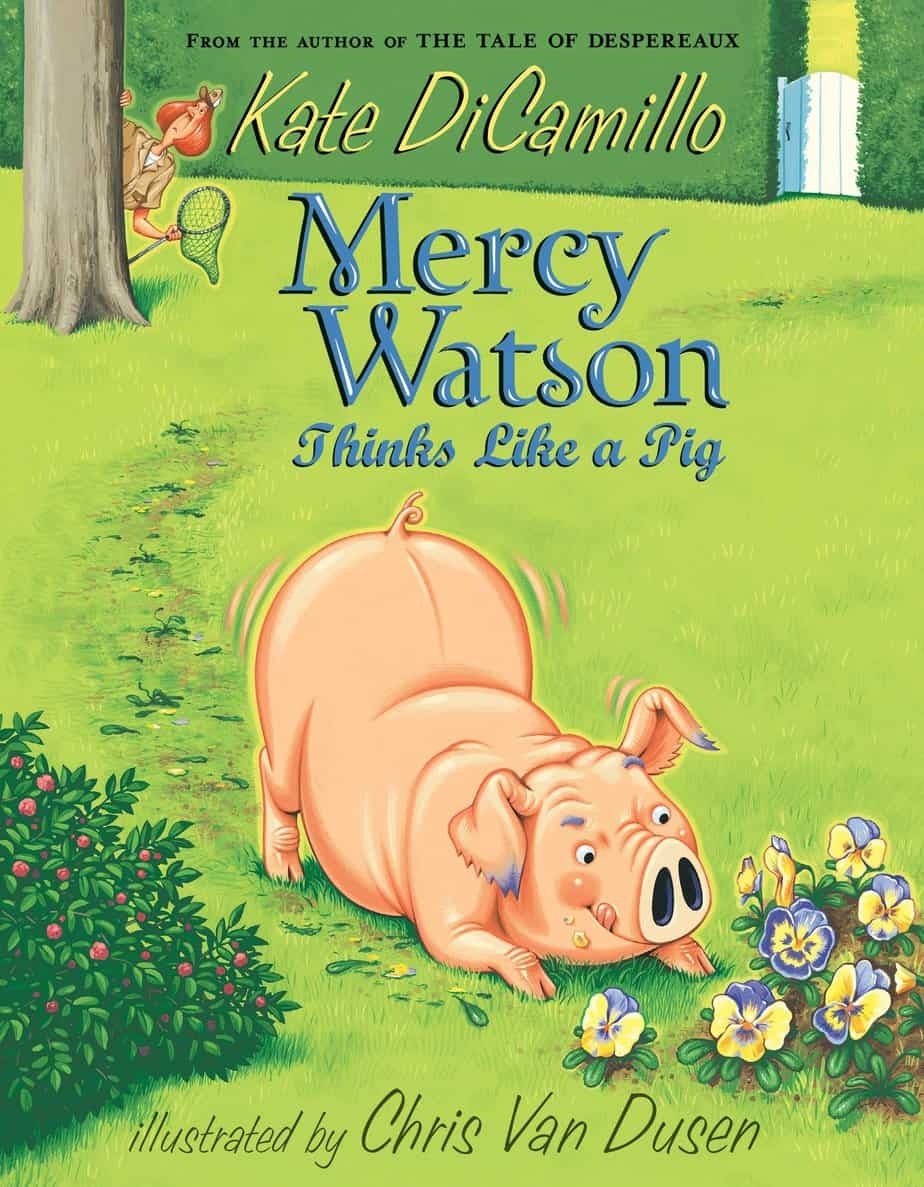Kate diCamillo’s Mercy Watson series are genius examples of funny, endearing, broad-audience picture books. There’s so much to learn. Today I take a deep dive into Mercy Watson Thinks Like A Pig.
Eugenia and Baby Lincoln may live next door to a pig, but that doesn’t stop them from living a gracious life. And the amiable Mercy Watson is equally determined to follow the delightful scent (and delicious taste) of the pansies her thoughtful neighbours are planting to beautify their yard. “Where have all the flowers gone?” shouts Eugenia, who is finally ready to take extreme measures — and dial Animal Control! Has Mercy’s swine song come at last? Or will her well-pampered instincts keep her in buttered toast?
marketing copy
Mercy’s appetite has got her into trouble again. When Eugenia Lincoln’s pansies go missing, Animal Control Officer Francine Poulet arrives on the scene. But as she soon discovers, not just anyone can think like a pig. Especially when that pig is porcine wonder Mercy Watson!
from the Teachers’ Notes issued by Candlewick Press
In common with Mercy Watson Fights Crime, the marketing copy centres Mercy’s opponent, Eugenia Lincoln. The educational notes centre the story-specific opponent. Either way, this story is about Mercy’s opposition, and I believe this is key to making these stories work. Mercy is too pig-like to make a sufficiently interesting character in her own right. Her Desires are basic; her Plan is always the same — to follow the joy. A character like this exists for her cute-appeal, but must be surrounded by very interesting opposition, and the opposition must make plans sufficient for a story.
NARRATION IN THE MERCY SERIES
This aspect of Mercy influences the narration, as well. The Mercy books are split into very short chapters (about 2000 words divided into 15 chapters = 133 words per chapter). Focal character changes with the chapter:
Chapter 1: Mercy and the Watsons sit happily at home doing something cosy together. In this case, they are drinking lemonade on the patio. There will be something not quite right in the world. In this case, Mrs Watson has put a lot of lemons in the lemonade and this makes Mr Watson’s lips pucker. This ‘something not quite right’ is comical but also foreshadows conflict to come.
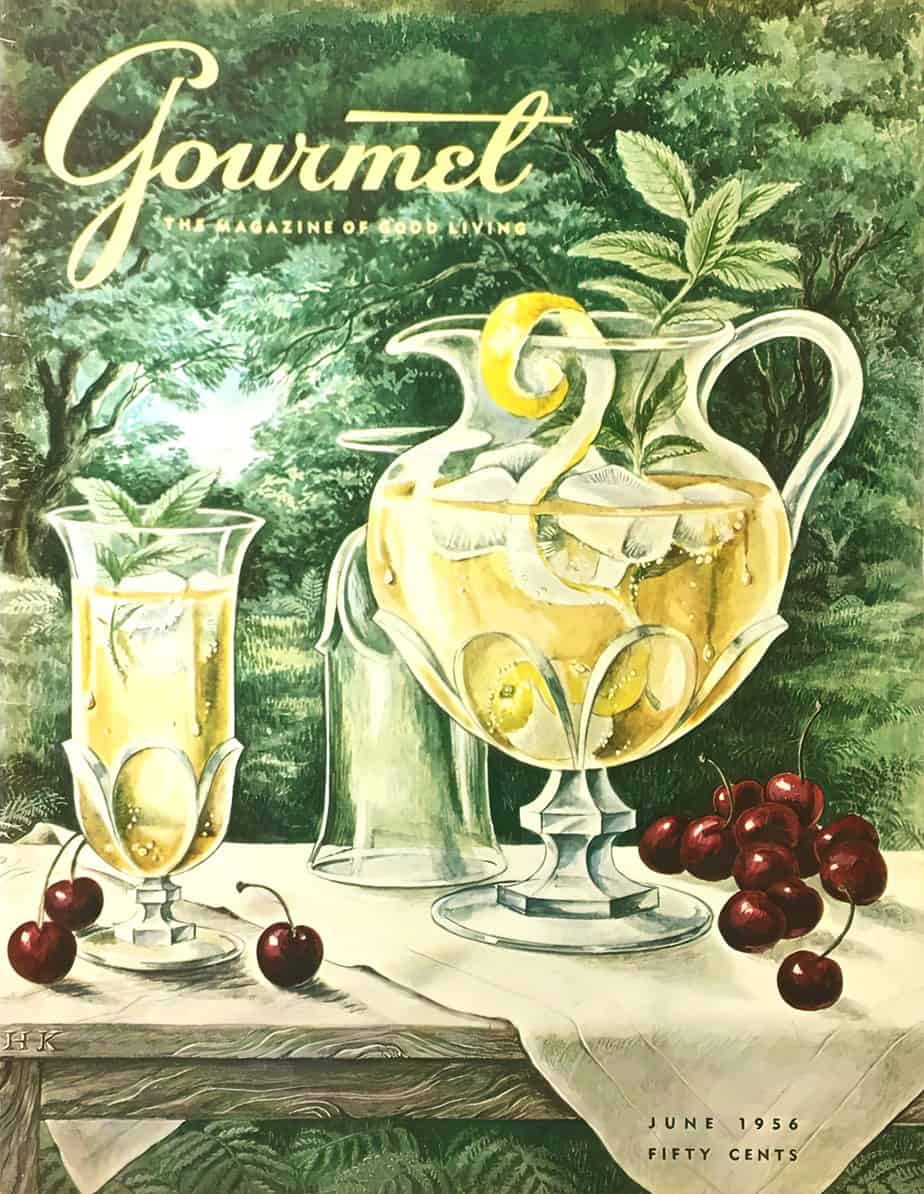
Chapter 2: Switches to Eugenia and Baby Lincoln next door. Eugenia isn’t happy that she’s living next door to a pig. They’re all outside on this hot day, and the pig is very evident. To counteract the fact of living next door to a pig, Eugenia decides they will plant pansies. Each chapter is a gag in its own right, with set-up and punch.
A joke has two parts: setup and punch. The setup raises the tension in the audience, if only for a moment, through danger, sex, the scatological–a host of taboos–then the punch explodes laughter.
Robert McKee, Story
In this chapter, the set-up is that Eugenia will plant petunias. The punch is that she will make Baby do the hard work of digging.
Chapter 3: We follow Mercy through a hole in the hedge into Eugenia’s yard. Mercy eats three pansies (The Rule of Three In Storytelling), with the full understanding that she goes on to eat every single pansy.
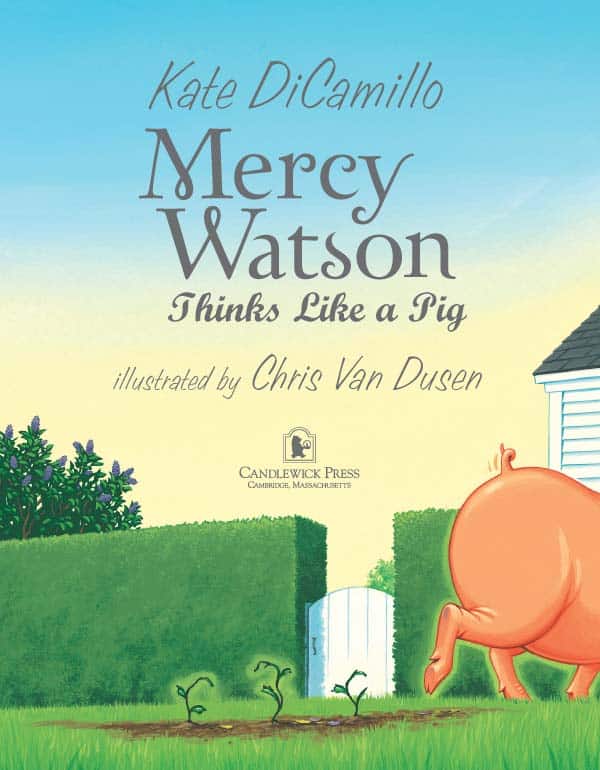
Mercy is depicted as happy and oblivious, with her eyes closed for most of it. Mercy is more animal than human, akin to a very small child. She wants whatever good thing appears before her. First it is the violets. (Next it is the prospect of food at a children’s party.)
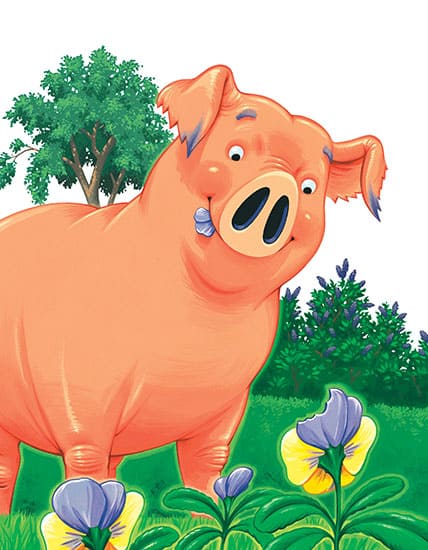
Chapter 4: As fully expected, Eugenia discovers Mercy has eaten all her pansies. The evidence is clear, as Mercy has pansy petals on her chin. This chapter ends with a chase scene. The look on Mercy’s face indicates Mercy thinks this is a game of chase. Eugenia’s hands are posed to look like she wants to strangle the pig.
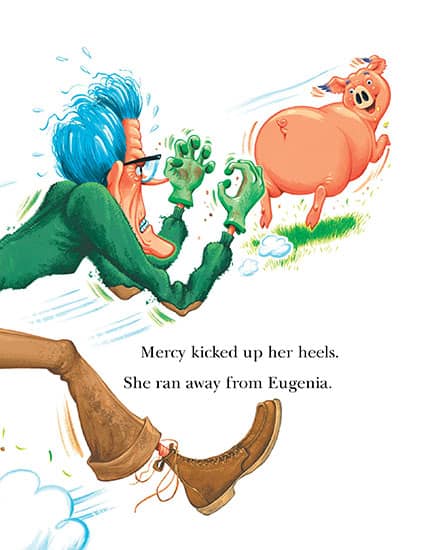
Chapter 5: Mr and Mrs Watson wonder where Mercy has gone. Interestingly, Baby pops up to add something to the conversation. Previously she was witness to Eugenia’s chasing Mercy. Baby is very much ‘the reader’ — she turns up when the narration needs her to be there. She says what the reader would like to tell the other characters. And she appears to ‘float’ from one scene to another. The gag in this chapter is that Mr and Mrs Watson also believe Eugenia and Mercy are playing a game of tag. “They look so happy!” Baby gently tells them that Eugenia is not happy. (The reader already knows this, too.)
The point of view continues to switch like this. Then a new character comes into the fold — the wonderful Francine Poulet.
STORY STRUCTURE OF MERCY WATSON THINKS LIKE A PIG
SHORTCOMING
Mercy doesn’t have much in the way of executive functioning, so when Eugenia next door plants violets — with the express purpose of making her forget they are living next door to a pig — Mercy can’t help but eat them. But this isn’t all that interesting, so for the purposes of this story, the main character is the chicken-bodied Francine Poulet (whose last name means chicken in French.)
Francine is comically single-minded. She has grandiose notions, and she fancies herself a superhero. Her single-mindedness will be her downfall (literally).
DESIRE
Francine relishes the challenge of locating a pig. She exclaims that this is a ‘career expanding opportunity’.
A NOTE ON LANGUAGE
Notice how Kate diCamillo uses these multisyllabic words within very simple sentence structures. It’s important that she’s able to use the words she would like to — otherwise much of the humour would be sacrificed. Note, too, that there’s nothing in ‘career expanding opportunity’ that can’t be sounded out.
OPPONENT
A note on Mercy’s series-long opposition:
Eugenia Lincoln calls Animal Control on Mercy. Eugenia functions as the long-term nemesis of Mercy, though Mercy remains blissfully unaware of this. Eugenia’s sister Baby is constantly trying to talk Eugenia down. She functions as the child reader, trying to persuade Eugenia that Mercy isn’t so bad. Unfortunately for Mercy, but fortunately for the plot, Baby fails in this mission every time because she is lacking in fortitude, assertiveness and is inclined to self-doubt. So the two sisters next door are an Opponent/Ally combo. This makes them especially useful.
After Eugenia calls Animal Control, Francine Poulet steps in as the main ‘Opponent’. But unlike Eugenia, Francine is a likeable character, and she is now The Main Character.
diCamillo establishes Francine’s likeability first during the phone conversation, in which Francine plays a guessing game with Eugenia. Francine is thereby set up as someone who enjoys fun.
For Francine, everyone on Deckawoo Drive is opposition, because nobody helps her locate the pig:
- The Watsons are so distraught they’re not making any sense.
- The Lincoln sisters disappear — they were only involved in the inciting incident of calling Francine in the first place.
- Stella is opposition because she has insisted Mercy wears a hat. This is the comedy mask trope, and prevents Francine from realising that Mercy is not a person (at first).
PLAN
Francine is depicted as the human version of a chicken, but her plan in this story is to ‘Think like a pig.’ This is Francine’s catch phrase. She repeats it to herself over and over.
Repetition is a basic building block of comedy. Lines which in themselves are not all that funny can become funny if repeated as part of a comedy. Stand-up comedians have lines/reactions that, when repeated, become even funnier.
Seinfeld’s Kramer — how he always has a dramatic way of coming through the door
The I.T. Crowd’s Roy — “Have you tried turning it off and on again?” (both repetition and mechanical behaviour)
We see Francine look increasingly animalistic v she really does look like a chicken as she leaps over the hedge. Next she’s down on her hands and knees sniffing about. Then her beaked-shape nose is in the air. Finally she is up a tree, like a roosting chook. Normally in stories, a human character is presented as a single animal. In Mercy Watson Fights Crime, the burglar is depicted as a weasel. Here we have an extra layer — a human depicted as a chicken pretending to be a pig. A veritable turducken.
And that’s why I love the titles of the Mercy series. The titles are especially apt — of course Mercy thinks like a pig. She IS a pig, and she’s a very piggy pig, too (unlike Olivia, for instance). It is actually the Animal Control woman who ends up thinking like a pig. The title both describes Mercy and subverts our expectations. (Too many titles ruin some of the fun by spoiling the plot.)
BIG STRUGGLE
The comedy mask comes off when Francine realises Mercy is wearing the blue hat. The reader has already realised this, if not from the preceding chapter, from the curly tail sticking out.
ANAGNORISIS
In lieu of a Anagnorisis we have the set-up and ‘punch’ — the big narrative punch is that Francine has caught Mercy after realising it was a pig wearing that hat.
NEW SITUATION
The books in the Mercy series always end in the same way — the characters come together on stage for a bow — they sit down and eat toast.
